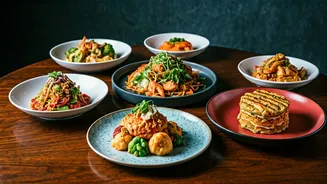Food Origins Unveiled
This culinary adventure begins by questioning the assumed origins of some beloved dishes often associated with Chinese cuisine. Many dishes, while bearing
a 'Chinese' label, have interesting backstories that place them in different countries or through specific cultural evolutions. These foods have journeyed through various cultures, adapting and evolving in unique ways. Their recipes reflect their origins, revealing a mix of influences and cultural adaptations that enriched their flavors and techniques. The following sections will spotlight six of these dishes, revealing their intriguing histories and global journeys, changing your perception of where your favorite foods came from.
Chop Suey’s Beginnings
Chop Suey is often considered a quintessential Chinese-American dish, however, it is actually a creation that emerged in the United States. Stories surrounding the creation of Chop Suey vary, but it's generally agreed that it was likely developed by Chinese immigrants in America. The dish's evolution reflects the resourcefulness of Chinese cooks in the U.S., who used accessible ingredients to create a satisfying meal. It embodies how Chinese immigrants adapted their cooking to suit local tastes and ingredient availability. This demonstrates the blend of cultures that made Chop Suey, featuring ingredients and flavors that would be familiar to American palates. This dish illustrates how cultural exchange impacted food.
The Real Story of Fortune
Fortune cookies, with their sweet messages, are synonymous with Chinese restaurants, particularly in America. However, these cookies, a staple in many Chinese-American dining experiences, originated in Japan. Japanese bakers in the United States began producing these cookies, eventually becoming popular in Chinese restaurants. The shift illustrates an interesting interplay of cultural adoption, as a Japanese creation became ingrained in the culinary landscape of Chinese-American culture. These cookies represent how food can travel across cultures, adapting and evolving in new and unexpected ways. Their presence in Chinese restaurants is a testament to the melting pot of culinary influences.
General Tso's Mystery
General Tso's chicken, a beloved dish in many Chinese restaurants across the world, is another example of a creation with a complex origin. Named after a Qing dynasty general, the dish was created in Taiwan. While the name pays homage to a Chinese historical figure, the chicken recipe itself is a contemporary invention, blending sweet and savory flavors that have become a favorite. This dish shows the fusion of food, history, and cultural identity. It demonstrates the creative adaptation of flavors, creating a dish that is deeply connected to Chinese culture in its identity.
Egg Rolls, Americanized
Egg rolls, a familiar appetizer found in many Chinese restaurants in the United States, have origins rooted in Chinese-American cuisine. These rolls represent a blend of Chinese cooking techniques with available ingredients in America. The fillings and preparation methods of egg rolls vary, but they often include cabbage, carrots, and other vegetables. This variation highlights the adaptive capacity of Chinese cuisine as it integrated local ingredients. This dish showcases the evolution of recipes as they adapt to diverse cultural preferences and available ingredients, which reflect the changing tastes of a new cultural context.
The History of Chow Mein
Chow Mein, is a staple in Chinese restaurants worldwide. Its history intertwines with the migration of Chinese communities, it is considered a Chinese dish. The popularity of Chow Mein is a testament to the impact Chinese food has on cultures globally. Its versatility allows for diverse variations, each reflecting the influences of the local ingredients and preferences. The continued success of Chow Mein is proof of the enduring appeal of the dish, showing how food becomes a vehicle for cultural exchange and global fusion. It showcases adaptability through time and place.
Conclusion: Culinary Travels
The journey through these six dishes provides insights into how cultural exchange can shape culinary landscapes. The dishes, once adapted and reinterpreted by various cultures, reflect the adaptability and creativity inherent in food. These culinary tales highlight the global nature of food and its power to connect people across diverse backgrounds. The next time you enjoy these dishes, take a moment to reflect on their origins and the rich history, and the blending of cultures that has led to the foods we enjoy today. Food is more than just nourishment; it’s a living history lesson.














